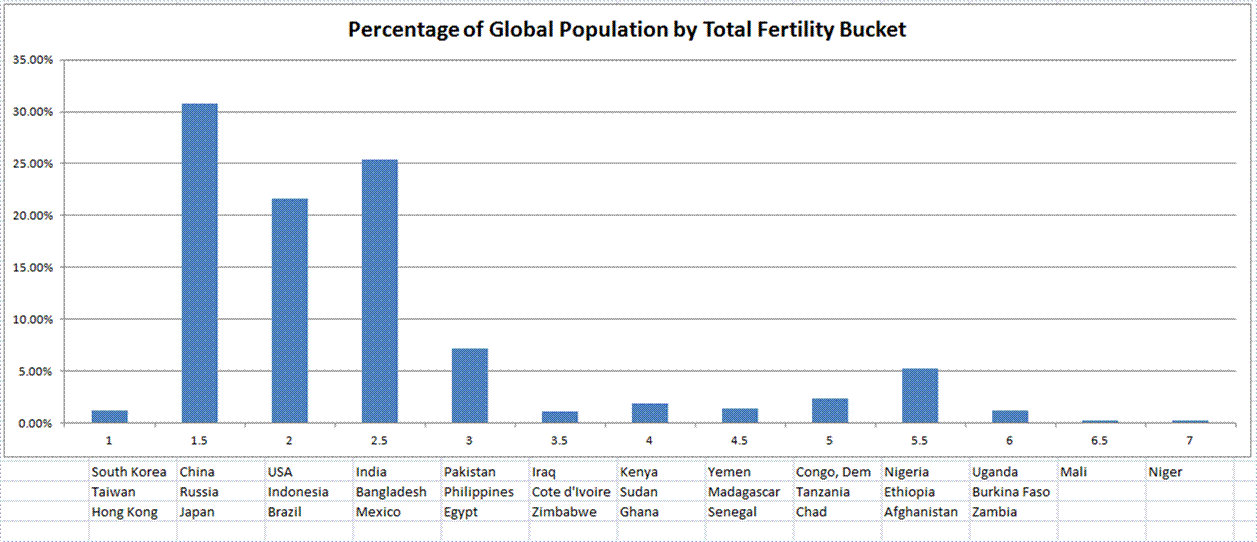I write about this every now and then, because human fertility is falling faster then most demographers expect.? Using the CIA Factbook for data, the present total fertility rate for the world is 2.45 births per woman that survives childbearing.? That is down from 2.50 in 2011, and 2.90 in 2006.? At this rate, the world will be at replacement rate (2.1), somewhere between 2020 and 2030.? That?s a lot earlier than most expect, and it makes me suggest that global population will top out at 8.5 Billion in 2030, lower and earlier than most expect.
Have a look at the Total Fertility Rate by group:
The largest nations for each cell are listed below the graph.? Note Asian nations to the left, and African nations to the right.
Africa is so small, that the high birth rates have little global impact.? Also, AIDS consumes their population, as do wars, malnutrition, etc.
The Arab world is also slowing in population growth.? When Saudi Arabia is near replacement rate at 2.21, you can tell that the women are gaining the upper hand there, which is notable given the polygamy is permitted.
In the Developed world, who leads in fertility?? Israel at 2.65.? Next is France at 2.08 (Arabs), and the US and New Zealand at 2.06, slightly below replacement.? We still grow from immigration, as does France.
Quoting from my prior piece, why is this happening?? There are many reasons why the total fertility rate is declining:
- Educating females makes many of them want to have fewer kids, whether the reason is pain, effort, wanting to work outside the home, etc.
- Contraception is more widely available.
- The marriage rate is declining globally.? Willingness to have children is positively correlated with marriage.
- Governments provide an illusion of support, commonly believed, that the government can support people in their old age, so people don?t have kids for old age support.
The rapidly slowing rate of childbearing will have global population peak in the early 2030s at a level in the lower 8 billions, unless there is some further change to attitudes on children that makes people have more or even fewer kids.
Some of those changes may come from:
- governments looking to stem a shrinking population that is causing a future problem with their social welfare programs.? (Note: in general, whatever governments offer, people don?t have materially more kids. Once women are convinced that kids are more of a burden than an advantage, they do not easily shift from that view, even if that view is wrong.)
- Various religious leaders realizing that the women are not with the program of growing their ranks, where contraception has become quietly common.? I am speaking mostly of Catholics and Muslims here.
- Abortion, especially for sex selection reasons becomes more or less common.? Growth in future population depends heavily on the level of fertile women, and if they are being killed or not at birth in places like China, India, the satellite countries of the former Soviet Union, etc? fewer women means a lower growth rate, and unhappier societies 20+ years out.
As I close, I want to list a few nations that are below replacement rate, that would surprise some people:
- Libya
- Vietnam
- Iran
- Qatar
- Lebanon
- Chile
- Uzbekistan
- Brazil
- Thailand
- Russia
- Azerbaijan
- Georgia
- Tunisia
- North Korea
- South Korea
And those the are close to replacement rate:
- Bangladesh
- South Africa
- Peru
- Burma
- Morocco
- Colombia
- Turkey
- Indonesia
- UAE
- Saudi Arabia (Wahabism is less strong than believed)
- India
- Mexico
- Venezuela
- Argentina
One last point, because the demographics profession has been slow to pick up on these shifts, if present trends continue, within 10 years, I believe you will see a scad of articles talking about the likely leveling off of global population and even future shrinkage of global population, and the effects thereof.? Always something to worry about?
| Libya |


You might be interested in this as well:
http://physics.ucsd.edu/do-the-math/2013/09/the-real-population-problem/
It shows the relationship between income and population growth. It’s more complex than I realized. At the low end of the income scale, there’s a sharp drop in population growth as wealth increased. After that, population growth increases with income, which I found quite surprising. This is partially because the author wasn’t able to disentangle immigration from fertility, unfortunately, but I don’t think that fully explains it.
There’s even more to worry about for some countries. Depending on the age distribution some countries could reach a point of no return (absent immigration) very quickly, while others have time to adjust. For example, Brazil has 41% of population below 25 (http://www.indexmundi.com/brazil/age_structure.html). Russia has only 28% below 25, and Japan 23%. At a certain point, the fertility rate needs to increase dramatically (in the fertile population) to even stabilize the population at a lower level rather than face an irreversible decline.